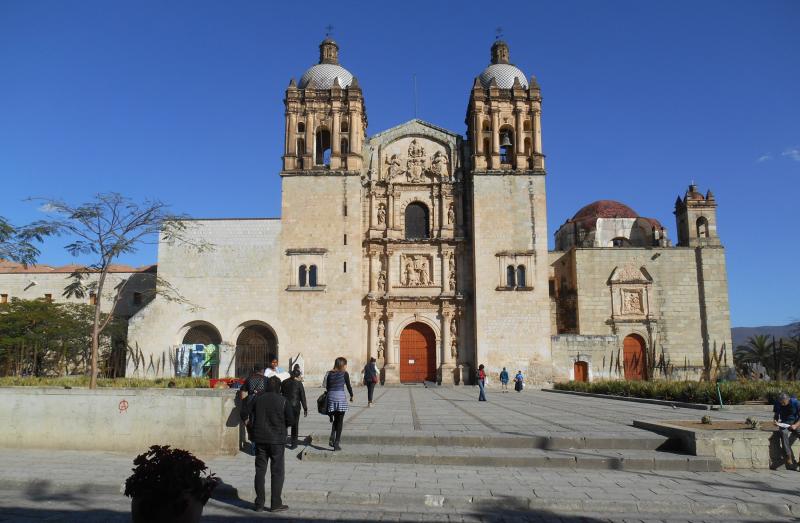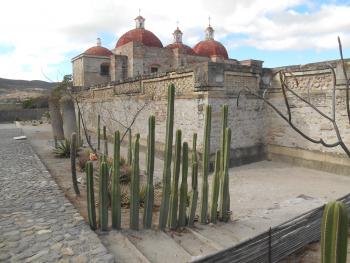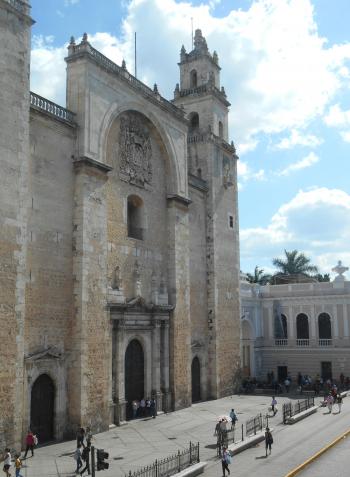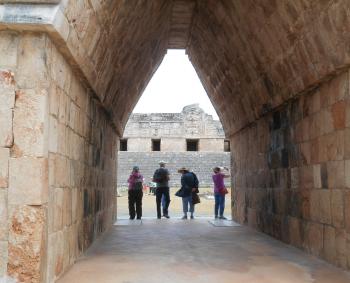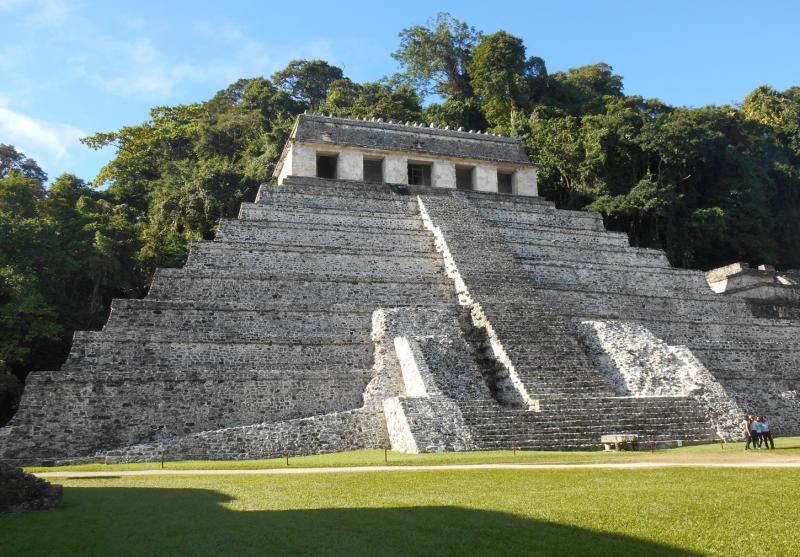Discovering the Colonial heritage – and pre-Hispanic gems – of Mexico
This article appears on page 32 of the October 2017 issue.
As an avid traveler, I am always attracted to the colorful liveliness of the colonial cities of the New World. So when Grand Circle Travel (Boston, MA; 800/221-2610, www.gct.com) introduced a new tour called “Mexico’s Ancient & Colonial Heritage,” which combined visits to the colonial cities of Oaxaca and Mérida with visits to five UNESCO World Heritage Sites in southeastern Mexico and the Yucatán Peninsula, how could I resist?
I made my reservation in November 2016 for the January 2017 departure, scoring a Last Minute Travel Deal. My cost for the tour, with a single room (GCT did not charge a single supplement), was $1,875.
I booked direct flights via Aeroméxico from Miami to Oaxaca, with return from Mérida to Miami, for a very reasonable $369. Two internal flights were included in the tour price.
My flight from Miami to Oaxaca was via Mexico City, and I used the 3-hour stopover time to have a light lunch and exchange currency at the very favorable rate of 20 Mexican pesos for one US dollar, so, in the prices I quote below, each peso is the equivalent of about a nickel.
Oaxaca
We spent four nights in Oaxaca at the Holiday Inn Express Oaxaca-Centro Histórico, rated No. 1 of 111 hotels in the city on TripAdvisor.com. The hotel serves breakfast (included in the tour price), but it does not have a restaurant on site for lunch or dinner. That gave me an opportunity to enjoy a tasty Italian dinner with a glass of wine (MXP140, or $7) at a nearby restaurant, Ciao Italia, and to savor typical Oaxacan cuisine at La Popular (MXP200) and Hostería de Alcalá (included in my tour).
The hotel is situated at the edge of Centro Histórico, so its location was ideal for our walking tours, which included visits to the exquisite exteriors and interiors of Templo de Santo Domingo and the city’s cathedral. The highly recommended Museo de las Culturas de Oaxaca is housed in the monastery adjoining Templo de Santo Domingo. Alas, the visiting hours did not coincide with my free time.
I did, however, get to enjoy the Museo de Arte Contemporáneo de Oaxaca, and a fellow participant in my group raved about the pre-Hispanic art collection housed in Museo Tamayo.
On our walking tours, we spent time at the Zócalo (Plaza de la Constitución), where we got authentic experiences intermingling with locals. We had ample opportunities for souvenir shopping at the colorful Mercado Benito Juárez, and a visit to a nearby chocolate factory introduced the group to the techniques for processing this important local export.
Day-tripping
On separate days, we made short-distance trips to visit two UNESCO World Heritage Sites in the vicinity of Oaxaca.
The site at Mitla displayed interesting geometric designs on the remnants of the pre-Hispanic Zapotec city, and it included the picturesque multidomed Iglesia de San Pablo.
At Monte Albán, another important pre-Hispanic Zapotec city, I was impressed by its vast size as I viewed it from its massive Gran Plaza.
The day-trip visits to these two archaeological sites provided a chance to make fascinating stops along the way. In Teotitlán del Valle, a weaving village, we visited the home and workshop of a local artisan, where we were treated to a demonstration of the weaving process. The artisan’s family served us a tasty lunch of local specialties, and on our way back to the bus, we stopped at the cemetery behind a local church, where two competing bands were memorializing the people buried there.
We also stopped to learn about another important local product. During a visit to the Mezcal Don Agave distillery, we were shown the agave plant, which is the basis for the liquor, learned about the production process and sampled several varieties of mescal along with snacks, including fried grasshoppers. I spent the rest of the afternoon in a copasetic haze.
Palenque
On the fifth day of the tour, the group flew from Oaxaca to Villahermosa via Mexico City. From there, we traveled for about two hours by bus through rolling countryside and past many cattle ranches to Palenque.
We stayed for the next two nights at Villa Mercedes Palenque, a comfortable resort that was a short drive from Palenque National Park. The resort was set on lovely grounds with bird-watching paths, a large swimming pool and a Mayan temazcal spa, where, for $90, one could get a complete treatment accompanied by traditional Mayan chants and music.
On the first night, an included buffet dinner was served in the hotel restaurant, but on the second night, a small subgroup from our tour opted to be transported to the town of Palenque for dinner at Restaurante Maya, where I enjoyed a reasonably priced (MXP160) local pork dish.
Lonely Planet lists just two sightseeing targets for the modern town of Palenque, and both can be found along the main street, Avenida Juárez. We got to see both.
At one end of the street, as you enter town, is the Glorieta de la Cabeza Maya, and at the other end is the lively and colorful El Parque. At El Parque, we enjoyed time listening to a concert and watching the locals socialize. We also stopped at a taco specialty restaurant, and our tour leader treated us to samples.
On the morning of our second day in Palenque, we drove the short distance to the archaeological site in Palenque National Park. The site is magnificently situated at the edge of dense jungle, which provided excellent photo opportunities.
The site contains several well-preserved buildings, including El Palacio with its tower; the Templo de las Inscripciones, and the Patio de los Cautivos (Prisoners). Physically fit visitors (which doesn’t include me) can climb and explore the buildings’ interiors.
On the way back to the resort, we stopped in a cooperative community for a late lunch and to view the waterfall at Cascada de Misol-Ha.
Mérida
On the morning of the seventh day of the tour, our bus took us on a return 2-hour drive to Villahermosa Airport, where we boarded a quick flight direct to the colonial city of Mérida.
After a brief orientation tour of the area of Centro Histórico around Plaza Grande (Zócalo) by bus, we were delivered to our hotel, where we would spend the final four nights of our tour.
The Gamma de Fiesta Inn Mérida El Castellano is smack-dab in the middle of the Centro Histórico, only four blocks from Plaza Grande. My room on the 10th floor was large and airy, with a fantastic panoramic view that included the Cathedral.
The staff was pleasant and accommodating, but the towering structure of the hotel did not fit in with the surrounding colonial architecture.
After lunch, I went off on an independent walk for a closer look at the area covered by our orientation bus tour.
For dinner, our tour leader walked us the couple of blocks from our hotel to Parque Santa Lucía, where there were several restaurants with outdoor seating surrounding the park. I chose to dine at a fine Argentine steak restaurant, La Recova, where dinner with a glass of wine set me back a whopping MXP240 ($12).
The Yucatán
The next morning, we drove for about 1½ hours to Uxmal, a premier archaeological site in the Yucatán.
The site is dominated by the visually stunning Pirámide del Adivino (Pyramid of the Magician). Other structures include the sprawling Cuadrángulo de las Monjas (Nuns’ Qudrangle), with its attractive façades and arches, the challenging Juego de Pelota (Ball Court) and the Palacio del Gobernador (Governor’s Palace). I had to settle for a side view of the latter because a detailed view of the long, front façade of the palace required the physical agility to climb a very steep set of steps.
For our included lunch, we headed over to Hacienda San Pedro Ochil, which was once important for its production of henequen fiber (from agave plants). The visit included a tour of the grounds and the on-site museum.
After our return to Mérida in the late afternoon, our guide treated us to an unadvertised activity. Those of us who wanted to visit El Gran Museo del Mundo Maya, a recently built futuristic structure on the city’s outskirts, could be dropped off there.
We spent about two hours gawking at the museum’s amazing collection of dramatically displayed Mayan artifacts before returning to the hotel by taxi.
After a brief rest, our tour leader escorted four of us to dinner at Pancho’s, a classy restaurant nearby with an unpretentious façade but a lovely, antique-filled interior. For about MXP260, I savored a succulent chicken dish with a glass of wine.
On the third day of our stay in Mérida, tour participants were offered an optional tour ($65) to the Biosphere Reserve at the fishing village of Celestún. Those who chose to go on the tour reported that they enjoyed the colorful flamingoes and the boat ride, and they indicated that they found it to be good value. However, I elected to stay in Mérida for more comprehensive and detailed visits to the city’s sights.
In the morning, I joined a free city walking tour. We stopped at the beautiful, pink City Hall (known locally as Ayuntamiento); Museo Casa Montejo; Museo Macay, in the former Bishop’s Palace; Catedral de San Ildefonso; Palacio de Gobierno, and Iglesia de Jesús. At each stop, our experienced guide described a brief history, the opening hours and what we could see on an independent visit.
After the tour ended, I enjoyed sitting for a while in the quiet Parque de la Madre near Iglesia de Jesús, then I retraced our tour route and paid the recommended detailed visits to each of the structures.
I was especially enthralled by the beautiful objets d’art in Iglesia de Jesús, the modern murals in Palacio del Gobierno and the furnished Victorian rooms in Casa Montejo.
In the evening, I set out for a solo dinner in the bright, colorful, colonial ambiance of La Casa de Frida. I ordered a specialty of the house, chile en nogada, with a glass of wine. The meal was delicious, and the cuenta came to only about MXP200.
After dinner, I sauntered back to Plaza Grande and lucked out by getting to see an attraction that I wasn’t aware was scheduled. A sound-and-light show with dramatic commentary (in Spanish), accompanied by music, was projected on the Cathedral’s façade. The effect was awesome.
Chichén Itzá
Our last day on the tour was reserved for a day trip to Chichén Itzá. A drive of about two hours took us from Mérida to the town of Pisté, the gateway to Chichén Itzá.
Our access to the site was via a private entrance along a path through the grounds of the Mayaland Hotel & Bungalows, where we had lunch after our tour.
Throughout the tour, there had been few other tourists at each of the archaeological sites, so it was smooth sailing and resulted in our ability to take unencumbered photographs, but, due to its notoriety, Chichén Itzá was more crowded. However, the density of the crowd was still not a problem, either for sightseeing or photography.
Entering the site, we were met by a breathtaking view of El Castillo, also known as the Pyramid of Kukulcán. Adjacent to that was the Grupo de las Mil Columnas (Group of the Thousand Columns) surrounding Templo de los Guerreros (Temple of the Warriors), with its statue of Chac-Mool kneeling at the summit.
Other awesome sights at Chichén Itzá included Plataforma de los Cráneos (Skulls Platform); Plataforma de las Águilas y los Jaguares (Eagles and Jaguars); Gran Juego de Pelota (Ball Court); Cenote Sagrado (Sacred Well), and El Caracol (Observatory).
Following our exhausting but satisfying trek, we enjoyed a buffet lunch at the Mayaland Hotel’s restaurant, with its singing and dancing wait staff.
After our return drive to Mérida, there was time for a last-minute shopping visit to Casa de las Artesanías before our included farewell dinner at La Chaya Maya, an elegant restaurant near Parque Santa Lucía. I ordered a delicious specialty of the house, cochinita pibil (slow-cooked pork).
My adventure was over. Late the next morning, after breakfast, it was a quick ride to the Mérida Airport to catch my mercifully short 2-hour flight back to Miami. My photographs and souvenirs will keep this terrific visit to Mexico’s colonial and pre-Hispanic gems poignantly in my memory.

